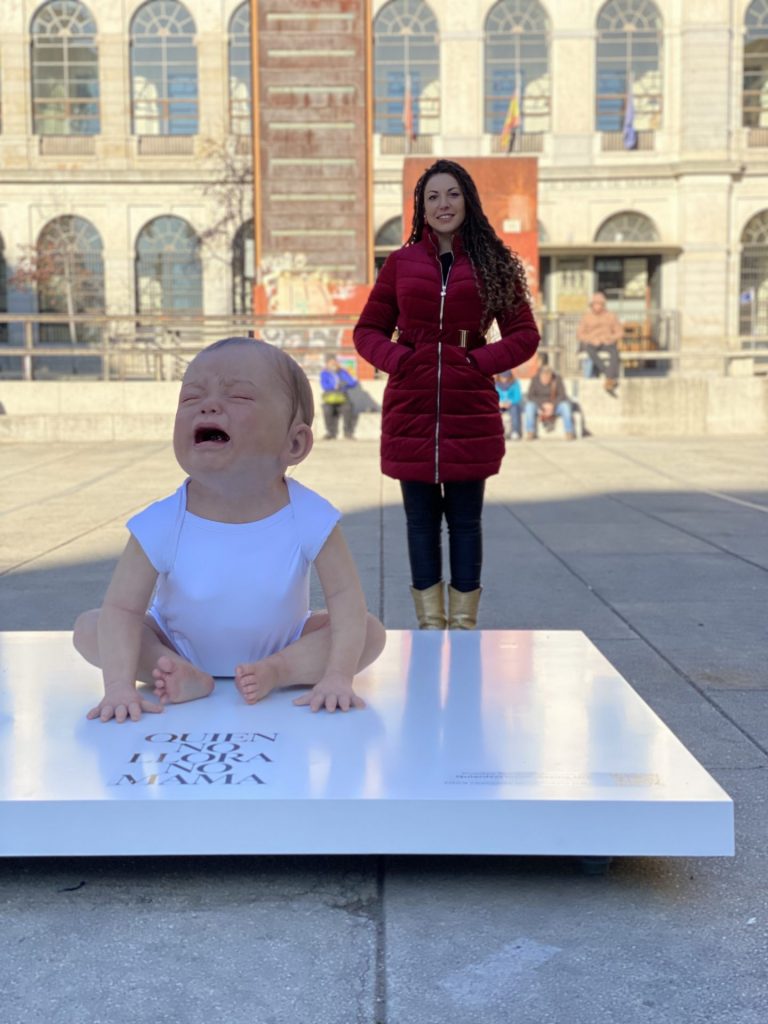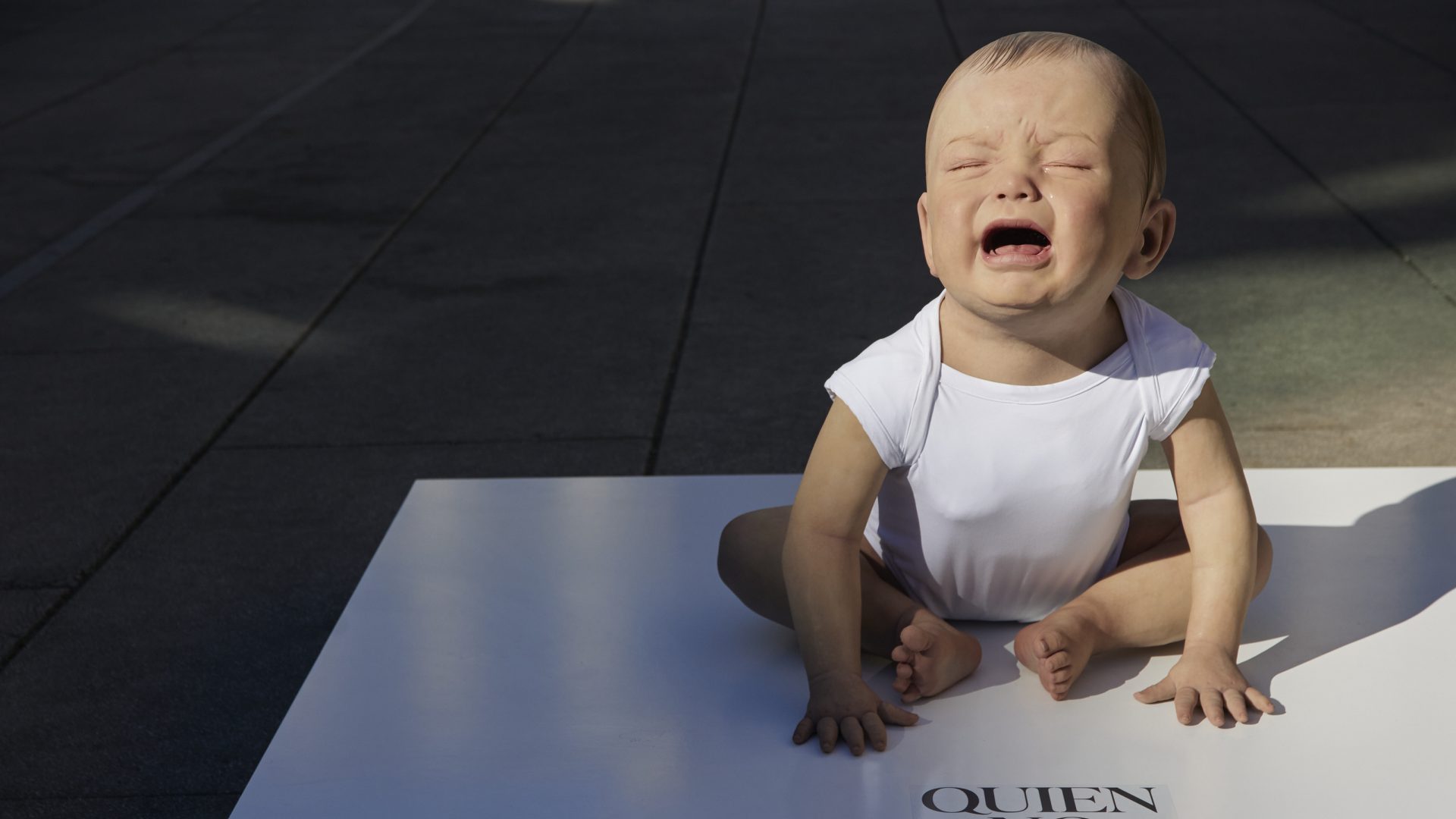Earlier this year, a baby was left crying on the cold stone plaza outside the Reina Sofía Museum in Madrid. Like most infants, he would not stop until he got what he wanted. But, unlike most infants, he did not need feeding or changing. This baby didn’t want the attention of his mother, but that of Spanish lawmakers. Because this was not a real child, but a hyperrealistic sculpture, a work of art with one sole purpose: to draw attention to the fact that mothers who breastfeed in public need more protection.
In Spain, the right to breastfeed in public is enshrined in law. In reality, however, as is the case with many other European countries, social tolerance is yet to catch up. Mothers can face insults and intimidation when breastfeeding in public. And while there is no prohibition against public nursing, there is equally no legal protection against harassment.
Now, a campaign by the advertising agency LOLA MullenLowe and the non-profit activist group Teta & Teta, entitled Quien No LLora No Mama (If You Don’t Cry You Don’t Get), wants to change that. Created by the Spanish sculptor Cristina Jobs, the wailing baby installation will journey around the country to raise awareness. He is programmed in a manner familiar to all mothers: to cry 24/7 until action is taken.
“This campaign is vital and has an obvious objective: to achieve a law that protects breastfeeding in public spaces. The challenge is that we do not know when we will achieve it and, therefore, we do not know how long this campaign will last.” This is according to Saray González and Helena Marzo, creative directors at LOLA MullenLowe.
The campaign found that mothers had fallen victim to a legal grey area: 15% of women aged 18-50 who breastfeed or who have breastfed have been actively criticised in public while nursing their infants. The same data set found that half of women hide in public while nursing their babies, with just 36% actually opting to breastfeed in public on a regular basis and 63.5% of mothers admitting they felt judged while breastfeeding.
One mother told the group that a woman had walked past her shaking her head, saying: “Really, I mean, on the street…” On another occasion, a man had attempted to peer under the shawl she was nursing her child beneath, telling her, “I’d like a bit of that.”
Unsurprisingly, 85.5% of women would like to see a law enacted to better protect them against this behaviour, including the artist whose hyperrealistic sculpture is now at the forefront of the campaign.
“It seemed like a project that was designed for me,” Jobs tells me. When she was first presented with the idea, she recalled how it was in line with her art. “My work is always about social issues, education and, above all, protest,” she explained, adding that she was “immediately captivated by the cause”. But there was also a personal element. She had heard of mothers firsthand who had experienced this kind of behaviour, but also, she said, “I have found myself in this situation.”
Jobs recounts: “I was sitting on a bench in a public park breastfeeding my daughter, waiting for my partner.” This offended the woman sitting next to her, who got very upset and told the artist that she should feed her daughter in a less public place. “‘This is not the place to stick out your chest’,” she said, before promptly walking away. “I was shocked. I didn’t know how to answer as, for me, I was not doing anything wrong. I was just feeding my daughter when she needed it.”

More than 50,000 people have signed the campaign’s petition to the ministry of health calling for a law to protect breastfeeding in all public spaces. If they succeed, Spain would join a small club, as legislation of this kind is rare across Europe.
In the Netherlands, home to an accepting attitude to public breastfeeding, legislation protects new mothers in the workplace. Employers must provide a separate nursing room for up to nine months after the birth and allocate 25% of their work hours to breastfeeding without it affecting their pay. In 2005, Scotland passed the Breastfeeding Act protecting the right to nurse in public, with a £2,500 fine awaiting anyone who infringes on that right. Otherwise, while the law permits public breastfeeding in Europe, it rarely has the ability to protect it.
“How hard could it be, right?”
YouTuber Olivia Garcia is talking about her 8,261km relocation from her home in Colorado to Leipzig. After meeting and falling in love with a German in Australia, in 2019 she made the decision to follow her heart and her now-husband to Germany. The move filled her with excitement, and now she documents her experiences as an American living in Europe on her YouTube channel. Soon, she faced yet another novelty; motherhood. Raising her first child in Germany, however, meant making room for another emotion: apprehension.
“Honestly, I was really nervous to start breastfeeding anywhere in public,” she explains, believing the hesitancy came from her US roots. But the more she heard about how accepting the country was to mothers nursing in public, the more her fears subsided. Then she did what her generation did best – she documented her experience online.
“When I made that video I had so many German mothers and fathers (and grandparents and au-pairs) message me to say that breastfeeding in public in Germany was ‘just a natural thing’.” So despite her nerves, Garcia has never had any bad experiences breastfeeding in public. “It’s almost a superpower,” she admits, adding that it has allowed her to connect with German women whom she usually finds “difficult to crack”. But then I told her a story that left her astonished.
The example I gave occurred in 2016. Johanna Spanke was nursing her three-month-old baby in a Berlin cafe when she was thrown out. It sparked a national debate over the need for a law to protect women from abuse while breastfeeding in public. “I honestly didn’t believe you,” she says. If it had been her, she knows exactly how she would have acted. Mortified at first, but then, having collected herself, she would have stormed back in, ready to call a lawyer. “So American,” she concedes, “I know.”
To this day, the only negative experience she has had was in America. To her surprise, it was from women in their mid-30s, aghast that she was feeding her baby in public uncovered. “They all scattered away from me like a water droplet falling on to a hot pan.” While breastfeeding in Germany, however, “I may as well be nice wallpaper,” she explains. She’s neither something to be gawked at nor debated – she’s just there.
According to the World Health Organization, France has the lowest breastfeeding rates in the world, at 70%. The country is also intolerant of public breastfeeding.
In June last year, the Louvre received a complaint from a mother who said she had been told to go to the toilet as her behaviour was disturbing other museum-goers. Breastfeeding her five-and-a-half-month-old daughter in the museum’s open spaces was deemed unacceptable. A statement issued by the museum’s authorities insisted it did not prohibit breastfeeding on its premises, nor did it identify the staff member involved. It also wasted no time in making clear that, in December 2021, the museum had installed a family room for private breastfeeding, complete with a “bottle warmer” and an “armchair”.
The irony of the situation was not lost on the mother. The Louvre is home to several pieces of art that depict breastfeeding. Andrea Del Sarto’s Charity (1518) celebrates the birth of the Dauphin, the long-awaited successor to the throne, and Andrea Solario’s The Virgin of the Green Cushion (1507-10) portrays the devotional nursing of the infant Christ. Evidently, on canvas and hung on the wall it is art to be displayed – for visiting mothers, it is something to be concealed.
A year earlier, an Australian mother faced similar treatment at Disneyland Paris. While breastfeeding her two-year-old baby on a park bench, three guards told the 33-year-old to stop at once and go to the designated child area. Appealingly, it was described as “a suitable and comfortable area with special breastfeeding seats”. In response, then-MP Fiona Lazaar proposed the creation of a new law to fine anyone who tried to prevent breastfeeding in public, €1,500 (£1,320) per offence. Still, when it comes to raising objections to nursing in public, the worst offenders are women.
In 2013, YouGov America found French women to be the least tolerant when compared with the UK and the US. When asked how acceptable they found it for a woman to breastfeed in public, 48% of French women said it was generally acceptable, compared with 76% of British women and 63% of American women. True to their stereotype, there was, however, one location where the acceptance of French women outranked their British and American counterparts – the beach.
In 2014, a study by Athens University’s neonatal department found that acceptance of public breastfeeding in France was rare. But it also found that in Mediterranean countries, although women are still discreet, attitudes are changing. In Italy, for example, during a ceremony in Vatican City, Pope Francis even encouraged women “to feed their babies anywhere, even in the Sistine Chapel, without thinking twice”.
But nearly 10 years later, Spanish women are still to see a lasting shift. Insults are still hurled, judgments are still made and some mothers still feel the need to hide away while breastfeeding. Perhaps what the cause needs, in order to make progress, is the simple yet enduring cry of an infant. Even a hyperrealistic one.
Now, Jobs’s sculpture has gone home. Undeterred and unrelenting, it can be found in Deltebre, her home town, where the baby was created. “It will be here for a few weeks,” she tells me, “then it will travel to another part of Spain to continue crying until the objective is achieved.”
Until then, his tears will continue to fall. After all, if you don’t cry, you don’t get.











